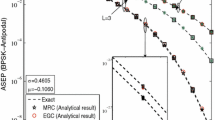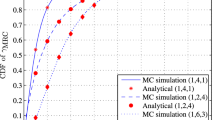Abstract
Selection diversity is a simple and potentially cost-effective combining method to combat fading with an antenna array. However, it is often assumed for true selection diversity (SD) and some of its variants that all branches are available all the time, i.e., that the receiver chain is duplicated for all elements. This allows the selection step to be performed after signal detection. Yet, since only one branch is used in SD at any given time to receive the desired signal, this diversity scheme can be implemented with a single complete receiver chain, switching means, and some simple means to measure signal power in each branch. This paper explores related practical issues, including the incorporation of the proposed scheme in 802.11-based wireless LANs and GSM cellular networks, and provides a performance analysis for such a selection diversity combiner implemented with inexpensive Schottky diodes as signal power measurement devices. Since power measurements thus obtained are noisy, the impact on performance is assessed through analysis in Rayleigh-fading environments. Performance parameters (PDF of output SNR, average output SNR, bit error probability for any modulation scheme) are obtained in closed-form and are compared with ideal selection diversity. It is found that performance can easily be less than 0.5 dB away from ideal selection diversity. Furthermore, the analysis is extended to include the effect of prolonged dwell time, i.e., the minimum interval between switching cycles is longer than the channel coherence time.
Similar content being viewed by others
References
J.A. Ritcey and M. Azizoglu, “Impact of switching constraints on selection diversity performance,” in Proceedings 32nd Asilomar Signals, Systems and Computer Conference, Pacific Grove, California, Vol. 1, pp.~795–799, November 1998.
J.H. Barnard and C.K. Pauw, “Probability of error for selection diversity as a function of dwell time,” IEEE Trans. Commun, Vol. 37, No. 8, pp. 800–803, August 1989.
G.D. Durgin, Space-Time Wireless Channels. Upper Saddle River, Prentice-Hall, pp. 213–214, 2003.
A.A. Abu-Dayya and N.C. Beaulieu, “Analysis of switched-diversity systems on generalized-fading channels,” IEEE Trans. Commun, Vol. 42, No. 11, November 1994.
Y.-C. Ko, M.-S. Alouini and M.K. Simon, “Analysis and optimization of switched diversity systems,” IEEE Trans. Vehic. Tech, Vol. 49, No. 5, September 2000.
E.A. Neasmith and N.C. Beaulieu, “New results on selection diversity,” IEEE Trans. Commun, Vol. 46, No. 5, pp. 695–704, May 1998.
Q. Wang, M. Lecours and C. Vergnolle, “Criteria for wide-band radial switch design,” IEEE Trans. Microwave Theory and Techniques Vol. 49, No. 1, January 2001.
Y.G. Kim and S.W. Kim, “Optimum selection diversity for BPSK signals in Rayleigh fading channels,” IEEE Trans. Commun, Vol. 49, No. 10, pp. 1715–1718, October 2001.
G.F. Montgomery, “Message error in diversity frequency-shift reception,” Proc. IRE, Vol. 45, pp. 1184–1187, July 1954.
G.-T. Chyi, J.G. Proakis, and C.M. Keller, “On the symbol error probability of maximum-selection diversity reception schemes over Rayleigh fading channels,” IEEE Trans. Comm, Vol. 37, pp. 79–83, Jan. 1989.
M.-S. Alouini and M.K. Simon, “Postdetection switched combining – A simple diversity scheme with improved BER performance,” IEEE Trans. Comm, Vol. 51, No. 9, pp. 1591–1602, September 2003.
M.K. Simon and M.-S. Alouini, “Probability of error for noncoherent M-ary orthogonal FSK with postdetection switched combining,” IEEE Trans. Comm, Vol. 51, No. 9, pp. 1456–1462, September 2003.
David~M. Pozar, Microwave engineering 2nd ed, J. Wiley & Sons, New York, 1998.
Agilent Technologies Application~Note 923, Schottky barrier diode video detectors.
—, ANSI/IEEE Std 802.11, 1999 Ed.: Part 11: Wireless LAN medium access control (MAC) and physical layer (PHY) specifications IEEE, Piscataway, NJ, U.S.A., 1999.
—, IEEE Std 802.11a-1999 (Supplement to IEEE Std 802. 11-1999): Part 11: Wireless LAN medium access control (MAC) and physical layer (PHY) specifications – High-speed physical layer in 5 GHz band, IEEE, Piscataway, NJ, U.S.A., 1999.
—, IEEE Std 802.11b-1999 (Supplement to IEEE Std 802. 11-1999): Part 11: Wireless LAN medium access control (MAC) and physical layer (PHY) specifications – Higher-speed physical layer extension in the 2.4 GHz band, IEEE, Piscataway, NJ, U.S.A., 1999.
—, IEEE Std 802.11g-2003 (Amendment to IEEE Std 802.11-1999): Part 11: Wireless LAN medium access control (MAC) and physical layer (PHY) specifications – Amendment 4: further higher data rate extension in the 2.4 GHz band, IEEE, Piscataway, NJ, U.S.A., 2003.
V.K. Garg and J.E. Wilkes, Principles and applications of GSM Prentice-Hall, Upper Saddle River, NJ, U.S.A., 1999.
A. Papoulis and S.U. Pillai, Probability, random variables and stochastic processes, 4th ed McGraw-Hill, New York, 2002.
O.C. Ugweje and V.A. Aalo, “Performance of selection diversity system in correlated Nakagami fading,” in Proc. 47th IEEE Vehic. Tech. Conf. (VTC’97) Vol. 3, pp. 1488–1492, May 1997.
L. Fang and G. Bi, “Performance of selection diversity reception in correlated Rayleigh fading channels,” Electron. Letters Vol. 34, No. 11, pp. 1071–1072, May 1998.
D.G. Brennan, “Linear diversity combining techniques,” Proc. IRE Vol. 47, pp. 1075–1102, June 1959.
R.J. Muirhead, Aspects of Multivariate Statistical Theory New York: J. Wiley & Sons, 1982.
A.P. Prudnikov, Y.A. Brychkov and O.I. Marichev, Integrals and Series vol. 3: More Special Functions Gordon and Breach Science Publishers, Amsterdam, 1990.
J. Proakis, Digital Communications McGraw-Hill, New York, 1995.
D. Zwillinger, ed., Standard Mathematical Tables and Formulae, 30th ed. CRC Press, Boca Raton, 1996.
W.C. Jakes, Microwave mobile communications J. Wiley & Sons, New York, 1974.
Author information
Authors and Affiliations
Corresponding author
Additional information
Sebastien Roy received the B. Sc. A. and M. Sc. degrees in electrical engineering from l’Université Laval, Québec, Canada, in 1991 and 1993, respectively, and the Ph.D. degree from Carleton University, Ottawa, Canada, in 2000. He is currently an Assistant Professor at the Department of Electrical and Computer Engineering, Université Laval, where he is pursuing research in the system-level and implementation aspects of signal processing for communications as well as space-time processing and space-time coding. From 2000 to 2002, he was a Natural Sciences and Engineering Research Council of Canada Postdoctoral Fellow at l’Université Laval. He has been active in industrial consulting and was involved in the organization of an international conference. Prof. Roy received the Post-Graduate Research Excellence Award from the Canadian Institute of Telecommunications Research in 2000.
Jean-Sébastien Néron received the B.Sc. degree in electrical engineering from École de technologie supérieure, Montréal, Canada in 2000 and the M.Sc. degree in electrical engineering from Laval University, Québec, Canada in 2005. He is currently working towards the Ph.D. degree on the design and realization of a wideband millimeter-wave smart antenna. He acquired industrial experience in various R&D departments especially on RF Modems, RF measurements and characterization, and embedded systems design. His research interests include planar antennas, microwave circuits, and channel characterization at millimetre-wave frequencies.
Rights and permissions
About this article
Cite this article
Roy, S., Néron, JS. The Impact of Estimation Error and Dwell Time on the Performance of Predetection Selection Diversity Receivers. Wireless Pers Commun 33, 87–108 (2005). https://doi.org/10.1007/s11277-005-7224-5
Issue Date:
DOI: https://doi.org/10.1007/s11277-005-7224-5




